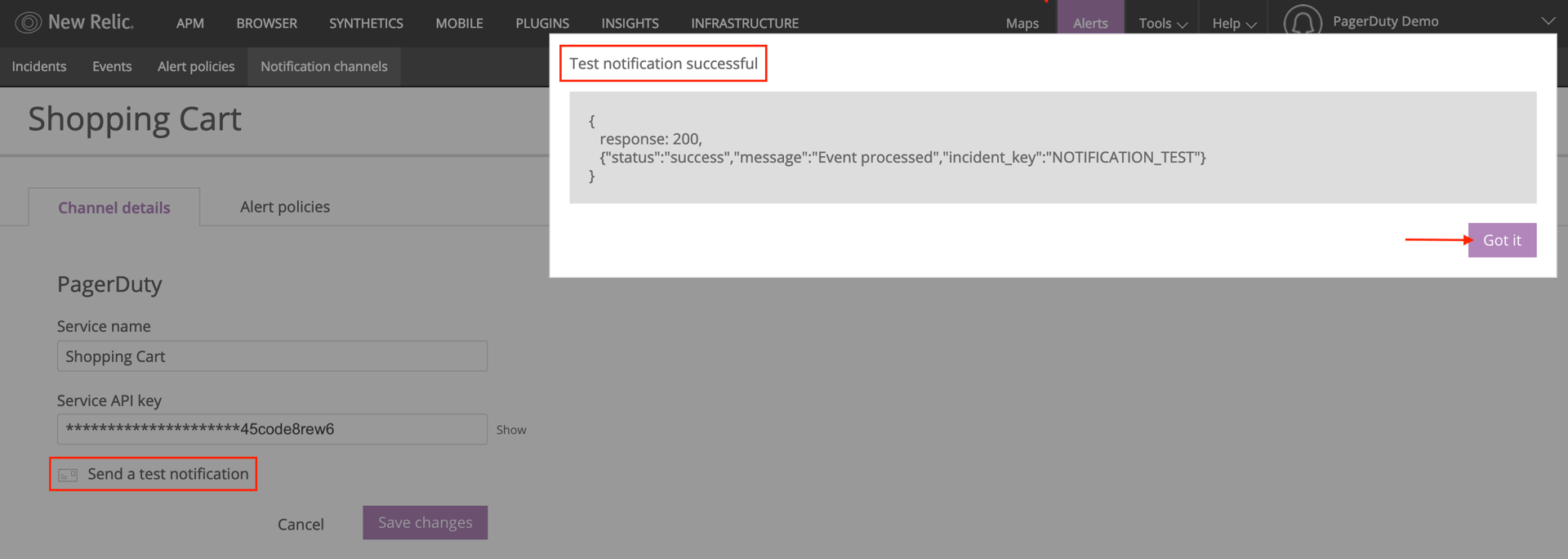- PagerDuty /
- Integrations /
- New Relic V2 Integration Guide
New Relic V2 Integration Guide
PagerDuty + New Relic Integration Benefits
- Notify on-call responders based on alerts sent from New Relic.
- Send richly formatted event data from New Relic.
- Create high and low urgency incidents based on the severity of the event
from the New Relic event payload.
How it Works
- New Relic metrics that fall outside of a designated range will send an
event to a service in PagerDuty. Events from New Relic will trigger a new incident on the corresponding PagerDuty service, or group as alerts into an existing incident. - Incidents will automatically resolve in PagerDuty when the metric in New Relic returns to normal.
Requirements
PagerDuty integrations require a Manager, Admin or Account Owner base role
or higher for account authorization. If you do not have one of these roles, please reach out to an Admin or Account Owner within your organization to configure the integration.
Integration Walkthrough
In PagerDuty
There are two ways that New Relic can be integrated with PagerDuty: via Global Event Routing or through an integration on a PagerDuty Service.
If you are adding New Relic to an existing PagerDuty service, please skip to the Integrating with a PagerDuty Service section of this guide.
Integrate with Event Orchestration
Integrating with Event Orchestration allows you to route events to specific PagerDuty services based on the payload of the event from the integrated tool. If you would like to learn more, please visit our article on Event Orchestration.
- Navigate to AIOps → Event Orchestration and select your preferred orchestration.
- Select the Integrations tab and then copy your preferred Integration Key. Keep this key in a safe place for use in later steps. When you have finished setting up the integration, you will return to this interface to specify how to route events to services in PagerDuty.
Integrating With a PagerDuty Service
Integrating with a PagerDuty service directly can be beneficial if you don’t
need to route alerts from New Relic to different responders based on the event
payload. You can still use service-level event rules
to perform actions such as suppressing non actionable alerts and adjusting the
severity.
- From the Services menu, select Service Directory.
- If you are adding your integration to an existing service, click the name of the service you want to add the integration to. Then select the Integrations tab and click Add a new integration.
If you are creating a new service for your integration, please read our documentation section Configuring Services and Integrations and follow the steps outlined in the Create a New Service section, selecting New Relic as the Integration Type in step 4. Continue with the In New Relic section (below) once you have finished these steps. - Enter an Integration Name in the format `monitoring-tool-service-name` (e.g., New Relic-Shopping-Cart) and select New Relic from the Integration Type menu.
- Click the Add Integration button to save your new integration. You will be redirected to the Integrations tab for your service.
- An Integration Key will be generated on this screen. Keep this key saved in a safe place, as it will be used when you configure the integration with New Relic in the next section.
In New Relic
- Go to Alerts, select the Notification Channels tab and then click New notification channel.
- Select PagerDuty from the Select a channel type menu. Give your channel a Service name, then paste the Integration Key (generated in step 2 of Integrating With Global Event Routing or step 5 of Integrating With a PagerDuty Service, above) into the Service API key field and click Create channel.
- Click Send a test notification to verify that your integration key was entered correctly and that an incident can be triggered in PagerDuty. Click Got it.
If you do not see an incident triggered in PagerDuty, check the response for errors and make sure someone is on-call for your service.

- After the channel has been created, go to the Alert policies tab and click Add alert policies.
- Check the alert policies that you want to trigger incidents in PagerDuty, then click Save changes.
Congratulations, New Relic will now be able to trigger and resolve incidents for this service in PagerDuty!
FAQ
Can you associate New Relic with more than one PagerDuty service?</strong >
Yes, you can tie New Relic to multiple PagerDuty services by creating additional services in PagerDuty and additional channels in New Relic which use different PagerDuty Service Integration Keys. This is extremely useful for organizing your alerts with their respective services and dividing them to different escalation policies so that the proper team is notified for relevant incidents.
Ready to get started?
Try any product on the Operations Cloud for free.
No credit card required.